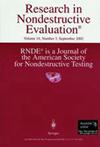Limitations of Sonic Echo Testing on Buried Piles of Unknown Bridge Foundations
IF 1
4区 材料科学
Q3 MATERIALS SCIENCE, CHARACTERIZATION & TESTING
引用次数: 0
Abstract
ABSTRACT Nondestructive Sonic Echo (SE) field tests have shown that this method does not have a satisfactory performance in determining the depth of piles fully buried underneath pile caps. In the current study, we endeavored to investigate the possibility of improving SE methodology to obtain interpretable results leading to determining the depth of buried piles in such foundations. The results obtained from the investigated numerical models indicated that the location of the pile toe could be determined when the height of the pile cap is less than 1 m. However, this value is questionable since it has been concluded in the absence of surrounding soil damping. In real bridge foundations with surrounding soils, the SE method may only be able to detect the length of a pile located beneath a cap with a height significantly smaller than 1 m. In summary, our simplified models show that the SE test is not a proper method to determine the length of fully buried piles supporting caps due to the limitations and difficulties discussed in the article.未知桥基埋桩超声回波检测的局限性
无损声波回波(SE)现场试验表明,该方法在确定全埋于承台下的桩深时效果不理想。在目前的研究中,我们努力探索改进SE方法的可能性,以获得可解释的结果,从而确定此类基础中埋桩的深度。数值模拟结果表明,当承台高度小于1 m时,可以确定桩脚位置。然而,这个值是值得怀疑的,因为它是在没有周围土壤阻尼的情况下得出的。在具有周围土壤的实际桥梁基础中,SE方法可能只能检测位于高度明显小于1米的承台下方的桩的长度。综上所述,我们的简化模型表明,由于本文讨论的局限性和困难,SE试验并不是确定全埋桩承台长度的合适方法。
本文章由计算机程序翻译,如有差异,请以英文原文为准。
求助全文
约1分钟内获得全文
求助全文
来源期刊

Research in Nondestructive Evaluation
工程技术-材料科学:表征与测试
CiteScore
2.30
自引率
0.00%
发文量
14
审稿时长
>12 weeks
期刊介绍:
Research in Nondestructive Evaluation® is the archival research journal of the American Society for Nondestructive Testing, Inc. RNDE® contains the results of original research in all areas of nondestructive evaluation (NDE). The journal covers experimental and theoretical investigations dealing with the scientific and engineering bases of NDE, its measurement and methodology, and a wide range of applications to materials and structures that relate to the entire life cycle, from manufacture to use and retirement.
Illustrative topics include advances in the underlying science of acoustic, thermal, electrical, magnetic, optical and ionizing radiation techniques and their applications to NDE problems. These problems include the nondestructive characterization of a wide variety of material properties and their degradation in service, nonintrusive sensors for monitoring manufacturing and materials processes, new techniques and combinations of techniques for detecting and characterizing hidden discontinuities and distributed damage in materials, standardization concepts and quantitative approaches for advanced NDE techniques, and long-term continuous monitoring of structures and assemblies. Of particular interest is research which elucidates how to evaluate the effects of imperfect material condition, as quantified by nondestructive measurement, on the functional performance.
 求助内容:
求助内容: 应助结果提醒方式:
应助结果提醒方式:


